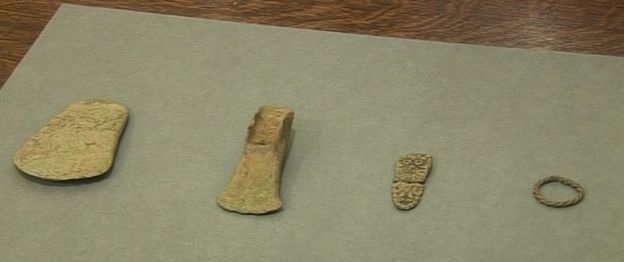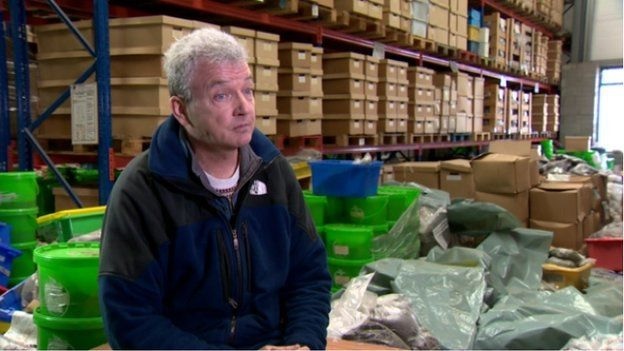Two and a half years ago I wrote an article designed to generate discussion on whether (or not) Irish metal-detectorists were saints or sinners. I had hoped to get more opinions from the professionals involved in Irish archaeology – from both sides of the border – but they have remained quiet.
An uneasy three-way ‘stand-off’ exists between the professionals and the hobbyists and the detectorists. A legal paradox also exists, i.e.
- According to the NMI The use of metal detectors to search for archaeological objects is illegal in Ireland unless you have a license
- These licenses are very difficult to obtain
- “The categories of objects that are most commonly located by metal detectorists in Ireland, such as coins, tokens, buttons, clothes fasteners, thimbles, keys, seals, weights, strap ends and belt mounts, all fulfil the definition of ‘archaeological objects’ which may only be searched for under license.” Source: National Museum of Ireland (NMI)
- Maplin (Dublin) sell metal detectors to the public and no restrictions are mentioned
- Easons (a nation-wide chain) sells a selection of books on the topic in Ireland
-
The treasure hunter’s handbook, by Brian Grove @ €13.99
-
Metal detecting, by John Clark @ €27.93
-
Metal Detecting, by Mark Smith @ €2.93
-
Metal Detecting, by John Clark @ €11.54
-
The Metal Detecting Bible, by Brandon Neice @ €6.00
-
The Successful Treasure Hunter’s Essential Site Research Manual: How to Find Productive Metal Detect, by David Villanueva @ €4.46
-
How to Use a Metal Detector for Treasure Hunting: Metal Detecting Tips and Guide You Need to Read, by Sherman Troy @ €6.14
- All prices are in Euro, so I assume they are aimed at the Irish market
- Do any of them contain an addenda for the Irish legal framework?
- I doubt it
-
- Alternatively, metal detectors purchased + certified by the Metal Detector Association of Ireland do appear to be legal – albeit under strict compliance of the definitions in the National Monuments Acts, 1930 to 2004
The result is that the Irish public are either confused or ignorant re the legal issues. Collectors are terrified that their collections, built up over decades, might be confiscated in their entireity if just one coin was deemed suspect by the National Museum of Ireland. In one instance, it was alleged that even the legal tender coins in a suspects purse were confiscated in a joint Garda-NMI search of a house. Collectors are understandably worried about expressing their concerns in public.
The verbal anecdotal (unofficial) messages from NMI employees vary:
- we cannot afford a scheme similar to the UK’s PAS
- we would rather archaeological artefacts never be discovered rather than allow amateurs be allowed to delve into our professional matters
- we are aware of a black market in Irish antiquities and we are determined to stop it
Professional archaeologists’ private opinions also vary:
- we would rather archaeology rot in the ground and go undiscovered than allow amateur metal detectorists get involved
- in theory, every field in Ireland contains archaeology, so rather than ban metal detecting at known sites of archaeological importance, it is better to ban it completely
- metal detectorists are nothing more than treasure hunters – they ignore and/or destroy contextual archaeology. As such, they should be banned.
Clearly a gap in knowledge and polarised behaviour/intent does exist. For example, it is accepted by all sides that some detectorists are just criminals intent on illegally removing archaeology and selling it for profit. Sadly, a criminal element exists in most professions and in most areas of society.
- Stolen treasure: The Coggalbeg Hoard
- Medieval stone window stolen from Leitrim island church
- Illegal treasure-hunters targeted by metal detector guidelines
- Nowhere safe as treasure hunters plunder our heritage sites ‘for profit’
The latest revelation from the NMI concerns a well-intentioned donation from an illegal finder who (probably) used a metal detector to find and illegally remove important Irish archaeological artefacts from (it is thought) several different sites.

Two illegally excavated Bronze Age axe heads, Viking strap-end and twisted ring
However, there are any positive attributes known to exist in organised, regulated metal detecting – as can be seen from PAS in the UK.
For those not familiar with PAS:
The British Museum, in conjunction with academics at Oxford, Cambridge and other educational institutions came up with the idea of a voluntary scheme whereby finders of treasure could record and report their finds in a scientific way – thus not losing valuable contextual information. They developed a process whereby :-
- All finds are reported, geo-located and described
- There is a process whereby important finds are quickly ‘flagged’ and acted upon
- All information is made available
- Additional information, when known, is added later, e.g. archaeologist(s) opinions
More than a million archaeological objects recovered by members of the public from across England and Wales have been recorded on the Portable Antiquities Scheme (PAS) database since 1997.
Meanwhile, another problem – much more urgent – has arisen. During the building boom, there was a record amount of road and houses building. But when the recession hit and some companies folded, the money dried up.
As a result, material was left sometimes unprocessed in warehouses in the Republic of Ireland and in other parts of the UK, and storage is now paid by the private companies.
Eoin Halpin, director of the company Archaeological Development Services, said:
“private companies can not be expected to pay for the cost of storing the items indefinitely.”
“I’m passionate about this material and this material can’t be allowed just to end up in a skip,”
According to a recent BBC News post,
“It cost millions of pounds to dig the material out of the ground, but because of storage problems, neither students nor the general public can access them.”
It has been reported that;
“At the warehouse in Kells, about a third of the hundreds of boxes of exhibits came from archaeological digs in Northern Ireland in recent years.”

Eoin Halpin said “fantastic” archaeological artefacts dating back over 6,000 years had been left in storage
Presumably, the rest of the stored, unclassified artefacts were excavated south of the border. I also look at the above photo and wonder how many ‘previously undiscovered’ coins there might be in there???
For example:
- Edward III
- Dublin Mint
- Penny – probably issued but no specimens found
- Richard III
- Three Crowns (1483-85)
- Half Groat – ordered to be minted but none found (yet)
- Penny – ordered to be minted but none found (yet)
- Halfpenny – ordered to be minted but none found (yet)
- Farthing – ordered to be minted but none found (yet)
- Three Crowns (1483-85)
- Henry VII
- Portrait issue (1490-1505)
- Half Groat – ordered to be minted but none found (yet)
- Penny – ordered to be minted but none found (yet)
- Halfpenny – ordered to be minted but none found (yet)
- Farthing – ordered to be minted but none found (yet)
- Portrait issue (1490-1505)
My proposal is simple:
- The companies that currently pay for storage, in conjunction with Social Welfare services on either side of the border, offer paid internships for unemployed archaeologists (former employees) to do an MPhil (by research) on the finds in their storage facilities.
- Irish universities offer free MSc’s to unemployed archaeology graduates who have completed an MPhil (by research) – again, on finds in these storage facilities.
- In addition, perhaps Irish universities could look at a specialist, part-time, “free” MPhil (by research) aimed at retired Irish numismatic enthusiasts
- The National Museum of Ireland and the Ulster Museum also offer paid internships for successful MSc holders to catalogue the finds in storage.
- In collaboration with the universities, perhaps the museums might consider a specialist, part-time (2/3 days a week) unpaid internship for retired Irish numismatic enthusiasts
- Subsequently, individual local authorities also offer paid internships for successful MSc holders to construct fully costed proposals for exhibits (obtained from construction projects in their jurisdiction) in existing county museums throughout Ireland.
- This might also include new county museums, or permanent exhibits at OPW sites within counties that do not have a county museum
- This will also include a proposal for prospective private sponsorship
- Alternatively, it could be a ‘crowd-funded social initiative’
- Or, a ‘national lottery-funded’ initiative
My proposal also suggests that the local museum exhibits follow three simple guidelines:
- exhibits are relevant to local primary schools’ curriculum
- another set of exhibits are relevant to Local History Society interests
- finally, a set of exhibits that showcase county ‘culture & heritage’ to tourists
This proposal is aimed at people who might be tempted to use metal detectors but would be better utilised as part of an initiative to reduce our huge stockpile of unclassified archaeological artefacts that are disintegrating in potentially unsuitable temporary storage.
Graduates of this initiative might be the future leaders of an Irish PAS.
What do YOU think?
If you like it, or have additional ideas / constructive criticism, please do get in touch.


